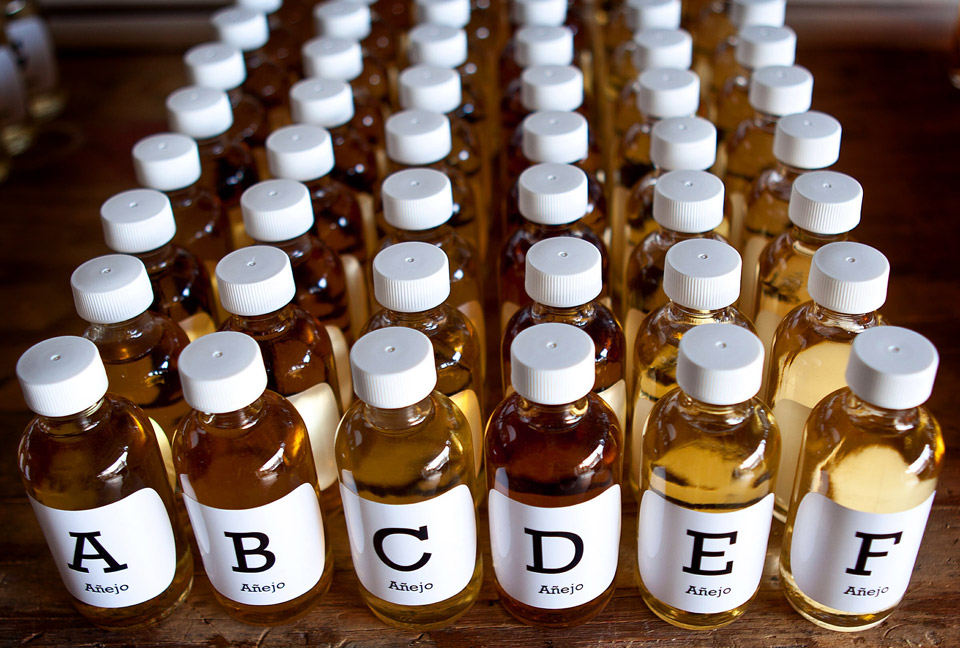[iPhone]
 The Most Powerful Tequila App Ever Created for the iPhone: Tequila Matchmaker
The Most Powerful Tequila App Ever Created for the iPhone: Tequila Matchmaker
[/iPhone]
[android]
 The Most Powerful Tequila App Ever Created for Android: Tequila Matchmaker
The Most Powerful Tequila App Ever Created for Android: Tequila Matchmaker
[/android]
For years tequila geeks have been having a debate as polarizing as Coke vs. Pepsi: Which location produces better tequila, the “Highlands” or the “Lowlands” of Jalisco, Mexico? (By the way, we object to the term of “Lowlands” to describe the Tequila Valley since the city of Tequila is actually at 3,870 feet above sea level, which is not “low.”)
Fans of the Highlands, also known as “Los Altos,” claim that the soil is richer, and so agaves grown there are sweeter and produce tequila that is fruitier-tasting. Proponents of the Tequila Valley often point out that the region has a better water supply and agaves grown there produce an earthier flavor. But, given that different production methods can produce wildly different tequilas, we wondered how much the Highlands/Tequila Valley debate actually mattered.
That’s why we decided to conduct our own blind tasting experiment, pitting 3 Valley tequilas against 3 Highlands tequilas.
Here’s the lineup:

- Tapatio Reposado (Los Altos)
- Casa Noble Reposado (Tequila Valley)
- Siete Leguas Reposado (Los Altos)
- Fortaleza Reposado (Tequila Valley)
- Don Lorenzo Reposado (Tequila Valley)
- Roca Patron Reposado* (Los Altos)
We had 27 members of our Tasting Panel rate and comment on these tequilas without revealing the theme, or even what they were tasting. All of the tequilas were purchased directly from retail establishments.
This was not a contest as to which of these tequilas are better than the others. The tequilas were selected by us because they are all high quality, and worthy of consideration by anyone who loves tequila.

From this small sample, we were made the following observations:
- There were no dramatic differences between the two regions. Differences that were detected were subtle.
- Both regions had the same number of “fruity” tequilas; neither had an edge over the other in this category.
- Tasting Panel members did find more earth and floral aromas and flavors in Tequila Valley products, consistent with expectations of the region.
- Tequilas from Los Altos, according to our panel members, had more vegetal (grassy) qualities, which is not consistent with common expectations of the region. These grassy notes are most often attributed to products from the Tequila Valley.
- 18% of panel members consistently rated tequilas of a certain region higher than the other, but 82% indicated no preference at all.

During our analysis of the results, we noticed that certain production methods influenced scores as much as regional influences did, indicating that how the tequila is made is just as important as where it was made.
Half of the tequilas (Siete Leguas, Fortaleza, and Roca Patron) in this lineup use a tahona (stone wheel) to crush their agaves, while the other half (Casa Noble, Tapatio, and Don Lorenzo) use the more modern roller mill.
When analyzing that data by focusing on this particular production method, we made the following observations:
- The tahona-made products had a slight edge, on average, in scores related to aroma (+3%), flavor (+2.3%), and finish (+2%).
- Tequilas that didn’t use a tahona scored higher in value (+6%), influenced greatly by the high value scores of Tapatio.
- Tahona products scored highest when the panel was asked if they would “Recommend to a Friend” (+9%), and if they would drink this again (+9%).
- When it comes to gender, the tahona process saw nearly identical scores (indicating that both genders responded equally favorable to it), but women rated non-tahona products higher (+5%) than men.
- 19% of panel members showed a consistent preference toward either tahona or roller mill, but 81% showed no preference at all.

The Bottom Line:
So, does the Highlands vs. Tequila Valley debate even matter? For a small segment of people, it does, but as it turns out, the production methods matter just as much or more. So, it’s not fair to judge a tequila simply based on where it is made. Although we were careful to select tequilas that source their agaves and distill their product in their same regions, this is difficult to determine with many products because agave can be sourced from various locations. You have to take all of the factors into account and see how it tastes to you.
[We may repeat this experiment in the future, using only blanco tequilas. This would take the wood aromas and flavors out of the equation and may provide a cleaner way of looking at this.]
It is tempting for tequila lovers to look at region or production methods for clues about their quality, but in reality the production of tequila is much more complex. How a tequila maker uses the equipment can produce extremely different results with the same machinery. The age of the agaves used and how they are cooked can produce a different result from tequilas from the same region.
Luckily, there’s an app for that! Try using the Tequila Matchmaker to help you discover the tequilas that are right for you, regardless of preconceived notions.
That said, if you’ve always been a fan of a certain region, tell us what you think of the results of our blind tasting experiment and let us know if you have and ideas for future blind tasting themes.
For more details about this blind tasting, please watch our video (above.)
We plan to continue with these blind tasting experiments, once per month for a full year. The panel will get larger, leading to more comprehensive results. Users of the Tequila Matchmaker can be invited to join the Tasting Panel by using the app and meeting a set of criteria designed to identify the most passionate tequila drinkers in our community. If you’re interested, get rating!
Salud!
[* – The full line of Roca Patron products are treated differently than the normal Patron. They are fermented with fibers only. The normal Patron process involved 50% with fibers, and 50% without.]





I LOVE THIS COMPARISON- OMG!!- Right up my tequila geeky soul. I cant wait to see a blanco comparison. This was VERY interesting. I have often wondered myself, which was my own preference. My favorite brands are sort of slit. I sort of like the boldness of El Valle, maybe not as sweet, and I like the butterscotch, earthy taste. I wonder if a blanco comparison would follow these comparisons. This is so cool. Please do more of these. FANTASTIC
Very interesting comparisons…especially the outcomes!!. I find that 7 Leguas ( which is one of my favorite tequilas) has a very distinct agave flavor combined with a taste of soil, a subtle hint of iron,and a slight lingering of citrus flavors. I don’t really have a. Preference between the tequila Vally and the highlands. I enjoy both regions. However, my two “Go to” tequilas at the moment, are Fortaleza and 7 Leguas , which one is from the valley and the other from the highlands. :). Of course there is an abundant existence of good tequilas put there!
I meant to say there are an abundant choice of tequilas “out ” there! ;-)
The comparison was very informative. I enjoyed the presentation and I’m looking forward to the next comparison.
The floral qualities found in both highland and lowland tequilas has everything to do with the Mexican heather found in both regions … Although a grass, it does produce small flowers, and the emphasis would actually come across as a more floral emphasis with grassy accents in a highland, and a more grass emphasis with floral accents in the lowland …
Thank you for conducting this interesting study! I am curious though, why not use blancos? I would think blancos, without being aged in wood, would best highlight the terroir of altos vs valles.
Yes, after we did this we had the same thought. I guess we will have to try this again using only blancos!
It’s been four years since your video and a year and a half since your last comment…have you managed to do the blanco comparison yet?
Nope, not yet. Right now is a bad time to conduct this test, though. Because of the agave shortage, many brands are sourcing agave from whatever region they can find — and what they are able to buy usually aren’t fully mature. We’re going to have to wait until the mature agave supply returns to normal before we can do an accurate comparison between the regions.
Close to 2 years and no update… disappointing, as the initial study and subsequent article was quite interesting, as a tequila aficionado. Has the Blanco experiment STILL not been conducted?! I’m pretty sure I’ve gone through 80% of the proposed Blancos to use in the “study” over the last 12 months, so a supply issue ain’t a problem [to use as an excuse].
Correct, the blanco experiment STILL has not been conducted. Maybe if we quit all of our day jobs we’ll have the time to make you happy?
A better comparison would be only BLANCO. The purest expression of terroir since ANY contact with ANY of the various wood used for rested juice changes the flavor profile.
Glad to see this discussion is still alive since I just found it for the first time five minutes ago.
Funny story: I just opened a bottle of Casa Noble blanco that I found on sale earlier today, and as I was sipping it (over a couple of ice cubes) I got to thinking about the question of whether it was from the lowlands or highlands. I found their site and learned that it was the latter; then I Googled “tequila highlands vs. lowlands,” and this site was one of the first hits.
Anyway, I’m with those who think that the only way to really do this comparison right is to do it with blancos. Once you start barrel-ageing, any (potentially subtle) differences are likely to disappear. I realize you can’t just launch a new research project on demand, especially given prices, but I hope you’ll be able to at some point. To the extent that cost is an issue, I think it would be just as valuable if you used low-to-moderately priced (puro) blancos rather than top-shelf brands. IMHO.